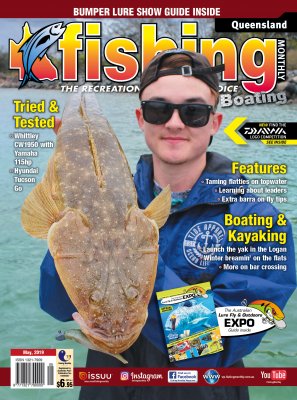Start skimming the surface for flatties by Dan Kaggelis
 When it comes to estuary surface fishing, the humble flathead flies very much under the radar. Although this species is commonly targeted using small hardbody lures, vibes or sub-surface soft plastics, many anglers fail to realise the topwater fishing potential these fish hold. You only have to take a moment to study the eyes of a flathead to see they are built to ambush prey and feed from below, making them the perfect topwater target.
When it comes to estuary surface fishing, the humble flathead flies very much under the radar. Although this species is commonly targeted using small hardbody lures, vibes or sub-surface soft plastics, many anglers fail to realise the topwater fishing potential these fish hold. You only have to take a moment to study the eyes of a flathead to see they are built to ambush prey and feed from below, making them the perfect topwater target.
While flathead aren't the most appealing target species, any fish taken on topwater is special. When you cast out that popper or stickbait and work it across the top only to watch it get slurped off the penthouse in a flurry of white wash and foam, it's hard not to get the pulse racing and the adrenaline pumping, no matter the species you are connected to.
So, how do you successfully target flathead on surface? It may seem pretty obvious. Go find a sand bank with current and bait, maybe where you caught them before, and start frothing the water until you get a bite. While there is some merit to this, there are a few things you may want to think about before taking up the challenge.
Firstly, before you fish a location think about its makeup and structure. The most common place to flick surface for flatties is over sand flats and sand bars. This is where they love to hide and ambush bait and also where you can access them in the shallow water.
There are plenty of shallow sand structures in creeks and estuaries, but not all will hold good numbers of flathead. I prefer sand flats that are bordered on the bank by small mangrove trees with an opposing deeper water drop-off. These mangroves are not too dense, on sand not mud, and provide channels for the high tide to penetrate.
The reason I prefer mangrove-lined banks is that during high tide the water will flow into these mangrove areas, providing a safe haven for small fish, prawns and crabs. However, as the tide begins to run out, these bait sources are forced to move out of their mangrove safe havens and onto the flats where they are exposed. Flathead know this and will wait until the tide turns, coming out of the deeper water drop-offs and up onto the flat ready for the food to come to them. This is why I prefer to target flathead on surface on larger high tides, as more water will bring in more bait. If the tides are too neap or the low tide is too high, water will not get into the mangroves enough or worse, stay in there keeping the bait from being exposed.
Obviously, there is no point chasing surface flathead on the top of the tide, as this is when the bait is protected on this type of sand flat and the flathead are in the deeper water. You want to be there at just the right tide height, when the water and bait is spilling from the mangroves triggering the fish to move onto the flats. If you take the time to watch this type of sand flat during the run-out tide you will notice an increase in bait activity as well as an increase in bait predation.